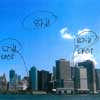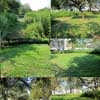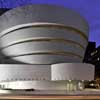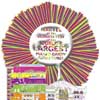Guggenheim Exhibition Queens, stillspotting nyc Finale News, Design Images
stillspotting nyc, Queens : Guggenheim Exhibition New York City
New York Guggenheim Exhibition – stillspotting nyc
Aug 11, 2011
Guggenheim Exhibition in Lower Manhattan
Composer Arvo Pärt and Architects Snøhetta Collaborate for Guggenheim Exhibition in Lower Manhattan
Second Edition of stillspotting nyc Series Exploring Stillness and Quiet in Urban Environment
Exhibition: stillspotting nyc: manhattan
To a Great City by Arvo Pärt and Snøhetta
Venue: Five locations around Lower Manhattan starting at Castle Clinton National Monument in Battery Park, across from 17 Battery Place, New York, NY
Snøhetta. Concept sketch for To a Great City, 2011
Digital photograph with handwriting

photo © Snøhetta 2011
Dates: September 15-18 and 22-25, 2011
(NEW YORK, NY – August 10, 2011) — For the second edition of stillspotting nyc, a two-year multidisciplinary project that takes the Guggenheim Museum’s programming out into the streets of New York City’s boroughs, Estonian composer Arvo Pärt and U.S. and Norway–based architecture firm Snøhetta create urban soundscapes around Lower Manhattan that explore the relationship between space and sound. To a Great City, the Manhattan edition of stillspotting nyc, will be open to the public for two extended weekends on September 15–18 and 22–25, 2011.
Stillspotting nyc is organized by David van der Leer, Assistant Curator, Architecture and Urban Studies, with Sarah Malaika, Stillspotting Project Associate, Solomon R. Guggenheim Museum.
Support for stillspotting nyc is provided by the Rockefeller Foundation NYC Opportunities Fund and a MetLife Foundation Museum and Community Connections grant. The second edition of stillspotting nyc is supported in part by the Royal Norwegian Consulate General in New York. The Leadership Committee for stillspotting nyc is gratefully acknowledged.
Snøhetta. Concept sketch for To a Great City, 2011
Ink on paper

photo © Snøhetta 2011
“While the vitality and stimulation of the urban environment can be pleasant, those living in or visiting densely populated areas such as New York are often unaware that their ears continually need time to adjust to strong differences between the sounds that surround them—just as the pupils of the eyes only gradually accommodate to the change from light to dark,” stated Van der Leer.
Pärt (b. 1935, Paide, Estonia) has described his music as a frame for silence and uses reduction of sound rather than augmentation to create his compositions. Pärt’s concept of tintinnabuli (“little bells” in Latin), which forms the basis of most of his work, was born from his vision for an extremely nuanced aural environment that could not be measured, so to speak, in kilometers or meters but only in millimeters. His pieces often revolve around a central tone that reappears consistently throughout the work.
The Guggenheim Museum organized a collaboration between Pärt and Snøhetta in which the architects have selected—and in some cases subtly altered—urban spaces that embody the concept of a central tone and extend the perception of sound into the realm of space. Visitors will experience this confluence of music and architecture at five separate locations downtown that quietly celebrate the city, ten years after the September 11 attacks.
Traveling through sites along the periphery of Ground Zero, participants may encounter a green labyrinth created by The Battery Conservancy, reflect in an underground chamber at Governors Island National Monument, and enter otherwise inaccessible spaces in landmark skyscrapers. The stillness and seclusion of these spaces heightens awareness and recalibrates one’s senses. Over the course of a day, participants may visit each space multiple times at their leisure to understand how their perception changes based on circumstances such as time, stress, appetite, and sleep. Listeners become increasingly sensitized as they are drawn in and ideally will be transformed to a focused and still state.
Snøhetta. Concept sketch of The Battery Labyrinth for To a Great City, 2011
Composite digital image

photo © Snøhetta 2011
Visiting To a Great City
To a Great City is presented around Lower Manhattan among five locations, starting at Castle Clinton National Monument inside Battery Park (between Battery Place and State Street). Hours are Thursdays through Sundays, September 15–18 and 22–25, 11 am–7 pm with the last tour starting at 4 pm. Visitors will receive a map, directions, and one-day access to each of the stillspots for a self-guided tour. A full visit, including each of the sites, takes approximately three hours, and visitors may opt to customize their route. Tickets are $10 for adults and $8 for members. Discounted rates are available for groups of ten or more. Advance registration is strongly suggested. To register and purchase tickets, find directions, or learn more visit stillspotting.guggenheim.org.
Interactive Programs and Studies for stillspotting nyc
In conjunction with the projects organized around the city, visitors may identify and plot out their personal areas of quiet and respite in a personalized map as part of the Create Your Own Stillspot program at stillspotting.guggenheim.org/create-your-own.
For stillspotting nyc, the Spatial Information Design Lab (SIDL) at the Graduate School of Architecture, Planning and Preservation at Columbia University was commissioned to develop a mapping study on silence and noise in New York City. The interactive map developed by SIDL presents actual noise complaints generated by New York residents when calling 311, the city’s phone number for government information and non-emergency services.
Reading the complaints offers insights into the city’s noise, and the contrasts between private and social space and between residential and commercial necessities. In addition, SIDL challenged 15 graduate students from the Architecture, Urban Design, and Urban Planning programs at Columbia University to investigate new concepts of stillness in a fast-moving city. Drawing from a series of seminars with speakers from various backgrounds, student work in the second half of the spring 2011 semester required inventing strategies for collecting data about silence and noise, and visualizing this data into concepts. As a result, the work questioned and redefined conventional ideas about noise, information, the city, and imagery.
A second visual study was developed with students in the MFA program in the Photography, Video and Related Media Department at the School of Visual Arts who created video studies of the visual, aural, and sociological ecology of the urban landscape. The interactive maps and videos are presented on stillspotting.guggenheim.org.
Schedule for stillspotting nyc
Following the Manhattan edition of stillspotting nyc, a third edition in Queens by American architecture firm Solid Objectives – Idenburg Liu (SO – IL) is planned for spring 2012. Subsequent editions planned through the winter of 2013 will be announced at a later date by the museum. The first edition, Sanatorium by visual artist Pedro Reyes, was presented in downtown Brooklyn in June 2011.
Improv Everywhere and stillspotting nyc
Over the two-year course of the project, the group Improv Everywhere explores the themes of stillness, silence, and noise in the urban environment through a series of performances in public spaces. Using undercover actors, the group has staged unexpected scenes for people to discover across New York City. These projects are documented online at youtube.com/guggenheim and will culminate as the final edition of stillspotting nyc.
About Arvo Pärt
The composer Arvo Pärt studied with Heino Eller in Tallinn before starting work as a sound engineer for Estonian Radio. He first gained recognition in the West in the 1960s with pieces such as Perpetuum Mobile and Nekrolog, best described as collage pieces, in which classical and modern music are combined. After the release of Credo in 1968, often considered his most extreme collage piece, Pärt looked for better ways to express himself through his music.
For eight years, he studied classical vocal polyphony and Gregorian chant at the Notre Dame school, which led him to create his signature compositional principle—tintinnabuli (“little bells” in Latin)—that sharply contrasts much of contemporary and classical music. While composers’ works often grow increasingly complex as their careers progress, Pärt’s music over the past few decades has been a search for the absolute essential, often employing an extreme reduction of sound. Fratres (1977) and Te Deum (1984) are among his most well-known works that have been performed around the world. Since the early 1980s, Pärt has resided in Berlin. Pärt is represented by Universal Edition Vienna.
About Snøhetta
Snøhetta is a design firm that specializes in architecture, landscapes, and interiors. The firm was created in 1989 in Oslo when its founding members won the competition to design the Alexandria Library in Egypt, and is currently based in New York City and Oslo. The collaborative and multicultural nature of the organization has allowed it to work in a wide range of areas in Asia, Africa, Europe, and the Americas.
Snøhetta has conceived a number of prominent cultural buildings, including the King Abdulaziz Center for Culture in Saudi Arabia; the James B. Hunt Jr. Library in Raleigh, North Carolina; the Petter Dass Museum in Norway; the Center for the Arts at Virginia Tech; the Queen’s University Performing Arts Centre in Ontario; the Ryerson Student Learning Centre in Toronto; the Wolfe Center for the Arts in Ohio; and the Museum of Environmental Sciences in Guadalajara, Mexico. Snøhetta has shown a keen understanding of sound and space through its design of the Oslo Opera House as well as smaller projects, such as the Kongsberg Jazz Festival Pavilion in Tubaloon, Norway. Currently, Snøhetta is working on its commission to design the National September 11 Memorial and Museum in New York.
About the Solomon R. Guggenheim Foundation
Founded in 1937, the Solomon R. Guggenheim Foundation is dedicated to promoting the understanding and appreciation of art, primarily of the modern and contemporary periods, through exhibitions, educational programs, research initiatives, and publications. Currently the Solomon R. Guggenheim Foundation owns and operates the Guggenheim Museum on Fifth Avenue in New York and the Peggy Guggenheim Collection on the Grand Canal in Venice, and provides programming and management for the Guggenheim Museum Bilbao.
The Deutsche Guggenheim in Berlin is the result of a collaboration, begun in 1997, between the Guggenheim Foundation and Deutsche Bank. The Guggenheim Abu Dhabi, a museum of modern and contemporary art designed by Frank Gehry on Saadiyat Island and adjacent to the main island of Abu Dhabi city, the capital of the United Arab Emirates, is currently in progress. More information about the foundation can be found at guggenheim.org.
Guggenheim Exhibition in Lower Manhattan information from Solomon R. Guggenheim Foundation
Guggenheim Presents stillspotting nyc : finale news, 2012
Location: New York City, NY, USA
Solomon R. Guggenheim Museum, New York, USA
1956
Frank Lloyd Wright

photo : David M. Heald, © SRGF, New York
Guggenheim Museum New York
Exhibitions – chronological list
Another Guggenheim Exhibition on e-architect:
Contraptions for the Production of Cultural Confections, Guggenheim Museum
2009
Ball Nogues Studio with Jessica Fleischmann

image : ballnogues with Seal
Guggenheim Exhibition New York
Comments / photos for the Guggenheim Exhibition Lower Manhattan page welcome
